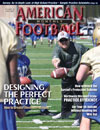Article CategoriesAFM Magazine
|
Trap Optionsby: John Gendronby: Tim Stowers former Head Coach, University of Rhode Island & Georgia Southern © More from this issue The core play of a spread option offense is the triple option. Defenses must commit to stop the triple. This commitment by defenses to stopping the triple will create the potential for big plays on the perimeter, especially as the game progresses. Two plays that give the spread option offense the ability to exploit this and get the ball outside are the trap option and the counter dive option. The advantage of these plays is that they allow you to get the ball outside without having the QB read his way out. This is achieved by having offensive lineman block the dive key, thus eliminating one of the QB’s reads. While both plays employ different backfield actions, they use the same blocking scheme. This simple concept of one blocking scheme for two plays is of great benefit to the offense and can create some problems for defenses.
|
|
|||||||
| HOME |
MAGAZINE |
SUBSCRIBE | ONLINE COLUMNISTS | COACHING VIDEOS |
Copyright 2025, AmericanFootballMonthly.com
All Rights Reserved





